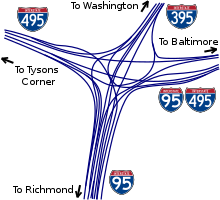Springfield Interchange
| Springfield Interchange | |
|---|---|

The Springfield Interchange as of 2007. In 2012, ramps from the I-95 HOV lanes (now Express Lanes) directly to the Capital Beltway (not shown) were built.
|
|
| Location | |
| Springfield, Virginia | |
| Coordinates: | 38°47′28″N 77°10′34″W / 38.791°N 77.176°WCoordinates: 38°47′28″N 77°10′34″W / 38.791°N 77.176°W |
| Roads at junction: |
|
| Construction | |
| Type: | Interchange |
| Constructed: | 1960s |
| Maintained by: | VDOT |
The Springfield Interchange, also known as the Mixing Bowl, is the interchange of Interstate 95, Interstate 395, and Interstate 495 in Springfield, Virginia, outside of Washington, D.C. The interchange is located at exit 57 on the Capital Beltway and exit 170 on I-95.
Some people, including many Washington-area media sources, refer to this interchange as the "Mixing Bowl" because, prior to the reconstruction, local and long distance travelers shared the same lanes and travelers had to merge to the right or left to reach the correct lanes for their destination. The last of this weaving and merging was eliminated on April 21, 2007. The interchange is one of the busiest highway junctions in the U.S., serving about 430,000 cars per day.
The interchange was originally built in the 1960s as a simple interchange between I-95 and the Capital Beltway. At the time, I-95 was expected to go through the District of Columbia. After community opposition prevented its construction through the city in 1977, I-95 was shifted to the eastern portion of the Beltway, between Springfield and College Park, Maryland, eliminating the I-495 designation there (although that designation was reinstated in 1989). Because of this route change, all traffic continuing on I-95 through the Washington area was exiting at Springfield through an interchange not designed for that purpose. By early 1970, there were 150,000 vehicles per day traveling through the intersection. Thirty years later, that number had more than doubled, with the effect that vehicles "traveling along the East Coast's main north–south artery [had to] be funneled through the ordinary exit ramps at Springfield, routinely causing backups several miles long."
A study by the National Highway Traffic Safety Administration determined the interchange to be the site of 179 crashes between 1993 and 1994—more than any other spot on I-95—and found that the number of ramp accidents was more than double that of any other Beltway interchange.
...
Wikipedia
